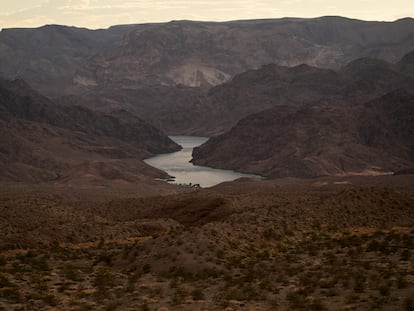Big flames and raining embers in New Jersey Pine Barrens fire
The cause of the fire is under investigation, but officials say the low humidity, high winds and dry fuel on the forest floor contributed to the blaze

Firefighters in New Jersey were confronted by 200-foot (60-meter) flames as they battled a wildfire tearing through 6 square miles of the state’s Pine Barrens, raining down embers and prompting evacuations but leaving no one injured and property intact, officials said Wednesday.
The blaze in Manchester, near Joint Base McGuire-Dix-Lakehurst, forced the evacuation of around 170 homes late Tuesday, with police and fire officials going door-to-door to ask people to take temporary shelter at a nearby high school. Helicopters were filling large containers with water from a nearby lake Wednesday and dropping it on the flames.
“We saw the red glow in the sky, and every time the wind would shift, it got worse,” said Jason Cylenica, who lives in the neighborhood closest to the fire. His wife, Cynthia Tiemper, said burning embers were landing in their back yard Tuesday night, making them decide to evacuate even before the fire department knocked on their door at 10:45 p.m.
“We left so fast I didn’t even bring socks,” she said. “It was like, ‘You grab the dog, I’ll grab this and let’s go.’ When we got back here this morning and saw that everything was still here, it was like prayers had been answered.”
The same conditions that helped spread the New Jersey fire were present in at least 20 states on Wednesday, according to the National Weather Service. The agency issued so-called “red flag warnings” in virtually every region of the country due to warm, dry conditions and stronger-than-usual winds which combine to increase the risk of wildfires, spokesperson John Moore said.
There’s no chance of rain until the weekend in the part of New Jersey where the fire is burning.
Forest fires are a common occurrence in the Pine Barrens, a 1.1 million-acre state and federally protected reserve about halfway between Philadelphia to the west and the Atlantic coast to the east.
“This fire exhibited extreme fire behavior,” said John Cecil, an assistant commissioner in the state’s Department of Environmental Protection. “I don’t mean to be dramatic, but this was a severe situation that these guys and gals managed to keep in a place and protect lives and property from that.”
About 75 firefighters, two helicopters, bulldozers and 15 fire engines were being used to battle the flames. The fire started Tuesday afternoon and was 50% contained as of noon Wednesday, according to Trevor Raynor, a warden with state’s forest fire service. Officials said they didn’t expect its perimeter to grow further.
Greg McLaughlin, chief of the New Jersey Forest Fire Service said the fire began on the grounds of Joint Base McGuire-Dix-Lakehurst, a military facility spanning several municipalities at about 4 p.m. Tuesday. Military personnel tried to extinguish it, but winds soon spread the fire beyond the base’s perimeter and across a busy highway, Route 539, necessitating a large response from numerous municipalities in the region.
A cause of the fire wasn’t given, but authorities said they’re investigating.
In the parking lot of a firehouse miles away from the fire scene, McLaughlin held up a plastic bag filled with small pieces of charred wood — dead embers that had flown through the air over two miles away and threatened to start new fires.
Last month, a wildfire in the Pine Barrens threatened over a dozen homes in Little Egg Harbor, not far from the site of a massive forest fire in 2007 at the New Jersey Air National Guard’s Warren Grove target range, which burned nearly 27 square miles.
Fire is an essential element of the Pine Barrens ecosystem; many of the pine trees there rely on heat from fires to release seeds from their cones, providing for the growth of new trees.
Sign up for our weekly newsletter to get more English-language news coverage from EL PAÍS USA Edition
Tu suscripción se está usando en otro dispositivo
¿Quieres añadir otro usuario a tu suscripción?
Si continúas leyendo en este dispositivo, no se podrá leer en el otro.
FlechaTu suscripción se está usando en otro dispositivo y solo puedes acceder a EL PAÍS desde un dispositivo a la vez.
Si quieres compartir tu cuenta, cambia tu suscripción a la modalidad Premium, así podrás añadir otro usuario. Cada uno accederá con su propia cuenta de email, lo que os permitirá personalizar vuestra experiencia en EL PAÍS.
¿Tienes una suscripción de empresa? Accede aquí para contratar más cuentas.
En el caso de no saber quién está usando tu cuenta, te recomendamos cambiar tu contraseña aquí.
Si decides continuar compartiendo tu cuenta, este mensaje se mostrará en tu dispositivo y en el de la otra persona que está usando tu cuenta de forma indefinida, afectando a tu experiencia de lectura. Puedes consultar aquí los términos y condiciones de la suscripción digital.
More information
Archived In
Últimas noticias
Raúl Rocha, from jet-setting with Miss Universe to arms trafficking and fuel theft
80,000 barrels of Mexican oil sent to Cuba: Havana drawn into the US–Mexico clash
Human rights activists, opposition members, and a minor: Maduro’s other political prisoners
Israel sparks a civil war within the MAGA movement
Most viewed
- Reinhard Genzel, Nobel laureate in physics: ‘One-minute videos will never give you the truth’
- Pablo Escobar’s hippos: A serious environmental problem, 40 years on
- Charles Dubouloz, mountaineering star, retires at 36 with a farewell tour inspired by Walter Bonatti
- Why we lost the habit of sleeping in two segments and how that changed our sense of time
- The fall of a prolific science journal exposes the billion-dollar profits of scientific publishing










































